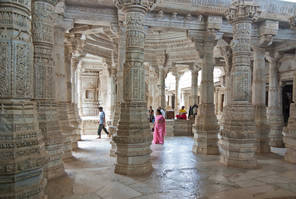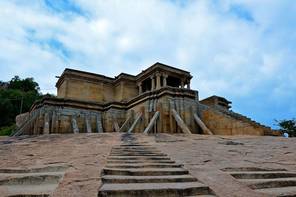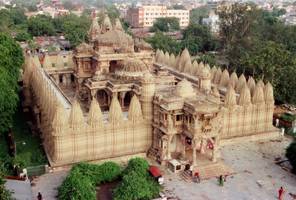Article: Maṇḍapa-line temples
The most common type of Jain temple construction in India is the maṇḍapa-line temple, raised by followers of the image-worshipping sects. Built by both the principal Jain sects of Digambaras and Śvetāmbaras, these temples are typical of all periods and can be found in all regions of the subcontinent.
In maṇḍapa-line temples the three core building elements – porches, halls and shrines – that form most Jain temples in India are arranged more or less in one long line. This line runs from the entrance to the principal image-chamber at the far end of the building.
While other Jain temple types also combine these three basic architectural elements, they do this in a distinct and not primarily linear fashion. Although other religions in India also use these elements in their temples, the architecture of Jain temples represents distinctive Jain principles and beliefs.
Worshippers enter the temple by ascending the platform on which it sits and going through the porch at the front, then progressing though one or several temple halls to the image-chamber, which is the sacred heart of the building. This may symbolise the journey to enlightenment that is the ultimate goal of Jainism, an aim that is also represented in other aspects of the temple.
Maṇḍapa-line temples are frequently composed of many examples of these three elements, which were often added to the original structure over time. How many entrance porches, halls and shrines a maṇḍapa-line temple has depends on its size, its fame and particular importance, its age and the present or past wealth of the religious community supporting it.
There are often numerous shrines and images as well as the main temple icon, which is housed in the image-chamber. The multiplicity of building elements that make up the temple and the smaller, simpler shrines outside the main structure combine to form an often elaborate temple complex. This mirrors the complex nature of the universe and Jain cosmology, and allows space for the large number of donated images, and more abstract symbols, venerated in Jain temples.
Building elements
The elements out of which maṇḍapa-line temples are assembled are simple.
The majority of Jain temples in India consist of the three core building elements of:
The followers of other religions in India, such as Hinduism, also use these elements for their own religious architecture, yet Jain temples are designed to support and reflect distinctively Jain beliefs.
The diverse ways in which these three elements can be arranged and multiplied are endless. Jain sacred architecture is particularly well known for its complex arrangements of entrance porches, halls and shrines, all raised on a moulded plinth. This characteristic organisation of building elements leads to a distinct structuring of space in Jain temples.
Religious ceremonies are usually performed within specific spaces in the temple. For example, offerings are made to images of Jinas and deities in dedicated image-chambers while hymns are sung and recitations performed in the temple halls.
Temple platform
All building elements in a Jain temple are elevated above the ground on a platform or terrace – jagatī or vedī – which is normally decorated. The terrace has a symbolic role as well as a functional purpose, underlining the Jain notion of effortful progress towards liberation.
The temple platform, which may be quite low or up to a few metres tall, is usually ornamented with abstract mouldings or floral and vegetal motifs. Especially tall and prominent platforms can be seen in the Odegal Basti at Shravana Belgola, Karnataka, and in the modern Jaina Temple at Bakara Road, Rajasthan. Some plinths are adorned with rows of geese and elephants, processions of horses and riders, battle scenes and lines of dancers and musicians. Such elaborate decorations can be found at the Neminātha Temple at Kumbharia and the Pārśvanātha Temple at Mirpur, both in Rajasthan.
The aim of the terrace is to raise the sacred temple structure from the dusty ground and to create an upward approach towards the holy icons housed inside.
In some instances, the terrace varies in height under different parts of the temple. In these cases the platform is lowest beneath the porch while it rises below the hall, reaching its highest point underneath the shrine. This creates the feeling of a slight upward climb towards the most important image-chamber, which is at the end of the succession of architectural elements. This can be seen in the Neminātha Temples at Nadol in Rajasthan and in the Neminātha Temples at Tirumalai in Tamil Nadu.
The platform may be wide enough to allow worshippers to use it for the ritual circumambulation – pradakṣiṇā – of the temple. See, for instance, the Ādinātha Temple at Kundalpur, Bihar and the Cintāmaṇī Pārśvanātha Temple at Hastinapur in Haryana.
Porches and halls
To enter a Jain temple, visitors go up the steps built at the front or cut into the terrace at the entrance. Larger temples usually have a porch leading to a hall.
The generic term for a temple hall Is maṇḍapa while a porch is commonly known as an ardha-maṇḍapa.
Porch
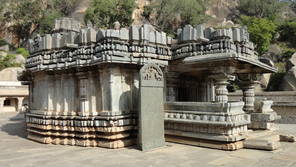
Akkan Basti
Image by HoysalaPhotos © CC BY-SA 3.0
A porch is a roofed structure outside a building’s entrance, attached to the external wall and projecting outwards from it. A porch may have open or closed sides and more than one storey. Porches are essentially very small, simple halls and provide access to shrines and larger maṇḍapas. Porches create spaces for people to pause before entering or leaving the building proper.
Porches are frequently called ardha-maṇḍapas but other terms can be used, depending on the region and style of the porch. Amongst the most common are:
- agra-maṇḍapa
- prāggrīva
- balana-maṇḍapa
- balānaka
- mukha-maṇḍapa
- mukha-catuṣkī
- mukha-catuṣkya.
Porches provide shelter against sun and rain and allow devotees to prepare themselves for the religious experience inside the temple.
In addition to the main entrance, through a porch, many temple halls have two side entrances, which frequently also have porches. Clear examples are the Sambhavanātha Temple at Sravasti in Uttar Pradesh and the Ādinātha Temple at Kulpak in Andhra Pradesh.
Temple hall

Thirupanamur temple
Image by Rishi Vandavasi © CC BY-SA 3.0
The temple hall – maṇḍapa – is a fundamental element in Jain religious buildings. It can take different forms, including being several storeys high or a free-standing structure. All temple halls in maṇḍapa-line temples, however, lead the devotee to the sanctum at the heart of the building, which contains the main image and is the centre of worship.
Larger halls can be open – raṅga-maṇḍapa or nr̥tya-maṇḍapa – with columns marking their boundaries at the sides. Such halls are particularly typical of central India, where they can be seen in the Caubārā Dehrā at Un. Looking into pillared halls from the outside, they are airy and flooded by sunlight.
Halls can also be closed – gūḍha-maṇḍapa – rooms, with walls at the side. Light and air is only admitted to such halls through one or several porches. A good example is the Pārśvanātha Temple at Khajuraho.
The space inside the halls, whether open or closed, is usually pillared. The pillars support the roof and structure the internal space into distinct areas. There are specific terms for halls with certain numbers of pillars or bays, such as the popular nine-bayed halls, referred to as trika-maṇḍapa, nava-caukī and nava-catuṣkī. Examples include the Mahāvīra Temples at Osian, Ghanerao, Sewadi and Kumbharia, all in Rajasthan.
There are also multi-storeyed temple halls – meghanāda-maṇḍapas – connected to raised image-chambers. These can be seen in the Ādinātha Temples at Ranakpur in Rajasthan and in the Bālā Bhāī Tunk on Mount Shatrunjaya in Gujarat as well as in many of the Jain temples in Varanasi, Uttar Pradesh.
Noteworthy are the detached open halls – sabhā-maṇḍapas. A prominent example can be seen in front of the Pārśvanātha Basti at Halebid, Karnataka. Although they are free-standing, they visually extend further the line of elements that are arranged along one axis in large maṇḍapa-line temples.
Temple halls create an approach to the shrine and house additional religious statues and ritual paraphernalia. They are used for ritual activities – pūjā – and the recitation of sacred texts. During larger gatherings, the devotees sing hymns and watch ceremonial dance performances in the temple hall.
Image-chamber and vestibule
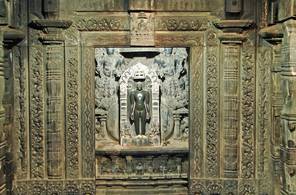
Jina figure in the image-chamber
Image by Dinesh Kannambadi © CC BY-SA 3.0
The innermost sanctum in which the main icon of a temple is housed is referred to as the garbha-gr̥ha – ‘womb chamber’. In temples with more than one shrine, the main image-chamber is usually referred to as the mūla-garbha as it contains the principal statue – mūla-nāyaka or adhi-nāyaka.
The cella of maṇḍapa-line temples is usually square and has no windows that let in natural light. In its simplicity and dimly lit state it resembles a cave inside a mountain, a model which the superstructure of the temple aims to copy.
Based on perceptions of ritual purity, sometimes not all devotees are allowed to enter the shrine, which is the purest and most sacred area of the temple. For this reason, a small vestibule – antarāla or kapilī – sits between the image-chamber and its adjacent hall. Worshippers can stand in this intermediate compartment to:
Spatial layout of maṇḍapa-line temples
In maṇḍapa-line temples, the porches, halls and shrines are arranged to create a straight line from the front entrance to the main shrine at the opposite end. This line may be stronger in large temples, which may be composed of several examples of such architectural elements. Other architectural elements may be used to lengthen the main alignment. Such additions to a simple original temple may have been made over centuries. However, areas where Jains enjoyed wealth and protection may have intricate maṇḍapa-line temples that were designed from the beginning to have many elements.
The maṇḍapa-line temple is characterised by an axis of clearly aligned architectural elements that echoes the ritual movement of devotees and priests into the temple. It is a journey from light, openness and abundant stimulation of the senses towards the darkness and simplicity of the confined inner space of the shrine at the far end.
The simplest form of a maṇḍapa-line temple consists of a single small entrance hall that gives access to a vestibule before the cella or immediately to the shrine. All major Jain pilgrimage centres in India have ample examples of this simple architectural form, as may be seen on the sacred mountains of Sona-giri in Madhya Pradesh and Shatrunjaya in Gujarat and at Karkal in Karnataka.
Larger temples of this type, however, have:
- a front porch
- more than one hall, of which often at least one is open and one is closed
- at least one shrine projecting from the end farthest from the main entrance porch.
The closed halls often have side entrances. Such central halls with side openings leading to side porches or subsidiary shrines are known as ‘large halls’ – mahā-maṇḍapas. These are particularly popular in north-western and central India. See, for instance, the temples at Kumbharia and Mount Abu in Rajasthan.
Developed Jain temples of the maṇḍapa-line type usually consist of large numbers of architectural elements aligned along a main axis. This arrangement of temple elements – halls and porches – serves the functions of:
- creating an approach to the sacred icon
- providing clearly defined spaces for the celebration of rituals
- hierarchically structuring holy space.
Completely detached platforms, halls, gateways – toraṇas – or water structures can be added to further lengthen the line of architectural elements. Two examples are the detached platform at Phalghat in Kerala and the line of gateways at Patan in Gujarat.
Often, Jain temples started simply but were enlarged by adding elements, such as additional halls and supplementary shrines, thus developing impressive dimensions over time. Most Jain temples combine building components from various centuries up to the present day. The older a temple, the more often it has usually been modified and enlarged.
During periods in which Jainism flourished and was supported by influential patrons, however, more elaborate temple constructions were also designed and built from the outset. Examples of such periods are the reigns of the:
- Solaṅkī dynasty in north-western India during the tenth to 13th centuries, which saw the building of the temple complex at Mount Abu, Rajasthan
- Hoysaḷa Empire in the south, lasting from the 11th to 13th centuries, with examples at Halebid, Karnataka.
Multiplicity in maṇḍapa-line temples
Multiplicity is an important issue in Jain temple architecture in general. In maṇḍapa-line temples, there can be multiple free-standing or interconnected shrines and many image-chambers. These may be arranged on both a horizontal level and on various vertical layers added to the building. This reflects Jain religious practice, and is related to the diverse objects of veneration housed inside the temples and to distinct Jain cosmological issues.
It is characteristic of Jain temples to accommodate large numbers of figural icons – of the Jinas and of gods and goddesses – as well as more abstract symbols. The latter can be:
- foot-imprints of the Jinas – pāda or pādukā
- sacred symbols – yantras or mantras
- manuscripts.
These are found inside the multiple shrines and halls on the ground floor, which form the typical spatial layout of developed Jain temples. Often there are further subsidiary image-chambers and interconnected levels of halls on additional levels inside temple structures. These can be raised sanctums as well as some which have been sunk into the ground. The most complex temples combine raised with subterranean layers.
Multiplicity is also created by surrounding these often very complex maṇḍapa-line temples with small shrines and subsidiary temple structures. These can be free-standing.
However, a typical architectural feature is to connect large numbers of small shrines, consisting of porches and image-chambers only – deva-kulikās or deva-koṣṭhas – to line or form the compound walls of a temple at the top of the tall terraces. Often, the walls between the individual shrines have been removed to create passages – bhamatīs or bhramantikās – used for the sacred rite of circumambulation – pradakṣiṇā. Such lines of interconnected deva-kulikā shrines surround the well-known Jain temples on Mount Abu and the Ādinātha Temple at Ranakpur, all in Rajasthan. Deva-kulikās too can be double-storied and may be linked to the central temple buildings on several levels, producing spatial patterns of great complexity.
- +
- aAbhavya
- aAbhinandana
- aAbhiṣeka
- aĀcāra
- aĀcārāṅga-sūtra
- aĀcārya
- aAchalbhrata
- aAḍhāī-dvīpa
- aAdharma
- aAdho-loka
- aAdhyayana
- aAdvaita Vedānta
- aĀgama
- aAghātīya
- aAghātīya-karman
- aAgnibhuti
- aAgra
- aĀhāra
- aAhiṃsā
- aAhimsa Day
- aAjita
- aAjīva
- aAkampit
- aĀkāśa
- aAkbar the Great
- aAkṣaya-tṛtīyā
- aAlauddin Khalji
- aAlbert Einstein
- aAllah
- aAlms
- aĀlocanā
- aAloka-ākāśa
- aAmāri
- aAmbikā or Kūṣmāṇḍinī
- aAnagāra
- aAnanta
- aAnarthadaṇḍa
- aAnaśana
- aAnekānta-vāda
- aAṅga
- aAniconism
- aAnojjā
- aAntarāla
- aAntarāya-karma
- aAṇu
- aAṇu-vrata
- aAnukampā
- aAnuprekṣā
- aAnusvāra
- aApabhraṃśa
- aAparigraha
- aAra
- aĀrambha
- aĀrambhaja
- aĀratī
- aArdhamāgadhī Prākrit
- aArhaṃ
- aArhat
- aArśana-āvaraṇīya-karma
- aĀrta-dhyāna
- aĀryikā
- aĀryikā Jñānamati
- aĀśātanā
- aĀścarya
- aAscetic
- aAsceticism
- aAshram
- aAspiration
- aĀsrava
- aAṣṭa-maṅgala
- aAṣṭāpada
- aAstikāya
- aAstrolabe
- aAsura
- aAtheism
- aAticāra
- aAtiśayakṣetra
- aAtithisaṃvibhāgavrata
- aĀtma-vāda
- aĀtman
- aAuṃ
- aAurangzeb
- aAuspicious
- aAusterity
- aAvadhāna
- aAvadhi-jñāna
- aĀvaraṇī-yakarman
- aAvasarpiṇī
- aAvatāra
- aAvidyā
- aAxiom
- aĀyāga-paṭa
- aĀyambil
- aĀyu-karma
- aĀyurveda
- bBabur
- bBāhubali
- bBaladeva
- bBālāvabodha
- bBandha
- bBasadi
- bBazaar
- bBhadrankarvijay
- bBhagavant
- bBhaktāmara-stotra
- bBhakti
- bBhale
- bBharata
- bBhāṣā
- bBhāṣya
- bBhaṭṭāraka
- bBhāva
- bBhāva-pūjā
- bBhāvanā
- bBhavana-vāsin
- bBhavya
- bBhavyatva
- bBhaya
- bBhoga-bhūmi
- bBhogopabhoga
- bBodhi
- bBollywood
- bBrahmā
- bBrahma-deva
- bBrahmacārī
- bBrāhmaṇa
- bBraj Bhāṣā
- bBright fortnight
- bBritish Raj
- bBuddha
- bBuddhi-sagar
- bBuddhism
- bBuddhist
- cCaitya
- cCaityavāsin
- cCakravartin
- cCakreśvarī
- cCāmara
- cCandanā
- cCandragupta
- cCandraprabha
- cCanon
- cCāritra
- cCāritramohanīya-karman
- cCarũrī
- cCaste
- cCaturvidha-saṅgha
- cCaturviṃśati-stava
- cCāturyāma
- cCE
- cCelibacy
- cCha
- cChadmastha
- cChastity
- cCheda-sūtra
- cChristian
- cChristianity
- cClergy
- cCloning
- cColophon
- cCommentary
- cConch
- cConfession
- cCongregation
- cConsecration
- cCosmology
- cCremation
- cCrore
- cCult
- cCūrṇi
- dDādā-guru
- dDalit
- dDāna
- dDaṇḍa
- dDark fortnight
- dDarśana
- dDarśanamohanī-yakarman
- dDaśa-lakṣaṇa-parvan
- dDeity
- dDelhi Sultanate
- dDerāsar
- dDeśāvakāśika-vrata
- dDetachment
- dDevanāgarī
- dDevānandā
- dDevarddhi-gani
- dDevotee
- dDhamal
- dDhanuṣ
- dDhāra
- dDharma
- dDharma-dhyāna
- dDharma-sāgara
- dDharmastikaya
- dDhātakīkhaṇḍa
- dDholak
- dDhyāna
- dDiaspora
- dDig-vrata
- dDigambara
- dDīkṣā
- dDisciple
- dDīvālī
- dDivya-dhvani
- dDNA
- dDoctrine
- dDogma
- dDonor
- dDoṣa
- dDravya
- dDravya-pūjā
- dDrone
- dDuṣamā
- dDuṣamā-duṣamā
- dDuṣamā-suṣamā
- dDveṣa
- dDvīpa
- eEast India Company
- eEightfold Path
- eEkānta-vāda
- eEkendriya
- eElder
- eElders
- eEschatology
- eEtc up to
- fFarmān
- fFast
- fFatehpur Sikri
- fFestival
- fFestschrift
- fFiruz Shah
- fFly-Whisks
- fFolio
- fFour Noble Truths
- gGaccha
- gGaṇa
- gGaṇadhara
- gGanadharavada
- gGaṇeśa
- gGaṇin
- gGarba
- gGarbha
- gGarbha-gṛha
- gGaruḍa
- gGati
- gGene
- gGenomics
- gGhātī-yakarman
- gGhātīya
- gGhaznavid
- gGhiyasuddin Tughlaq
- gGhurid
- gGloss
- gGotra-karma
- gGujarāt
- gGujarati
- gGuṇa
- gGuṇa-sthāna
- gGuṇa-vrata
- gGupti
- gGuru
- gGuruṇī
- hHagiography
- hHajj
- hHaṃsa
- hHaribhadra
- hHariṇaigameṣin
- hHasta
- hHeresy
- hHiṃsā
- hHindi
- hHindu
- hHinduism
- hHīravijaya
- hHoroscope
- hHrīṃ
- hHumayun
- hHymn
- iIconoclasm
- iIconography
- iIdol
- iIndian Independence
- iIndology
- iIndra
- iIndrabhūti Gautama
- iIndriya
- iInitiation
- iIntercession
- iInvocation
- iIQ
- iIslam
- iIslamicate
- iIṣṭadevatā
- iĪśvara
- jJagat
- jJahangir
- jJain
- jJaina Devanāgarī
- jJaina Śaurasenī
- jJaina-dharma
- jJainaśāsana
- jJainness
- jJaisalmer
- jJamāli
- jJambū-dvīpa
- jJames Burgess
- jJanma
- jJanma-kalyāṇa
- jJarā
- jJāti
- jJina
- jJina-āgama
- jJina-bhavana
- jJina-bimba
- jJina-mātā
- jJinacandra-sūri
- jJinadatta
- jJinaprabha
- jJīva
- jJñāna
- jJñāna-āvaraṇīya-karma
- jJñāna-āvarṇiya
- jJñānsundar
- jJyotiṣka
- kKāla
- kKālakācārya-kathā
- kKālidāsa
- kKalpa-sūtra
- kKalpa-vṛkṣa
- kKalyāṇaka
- kKalyanvijay
- kKamaṇḍalu
- kKamaṭha
- kKarma
- kKarma-bhūmi
- kKarma-grantha
- kKarma-prakṛti
- kKarma-vāda
- kKarmon
- kKarnataka
- kKaṣāya
- kKathā
- kKāvya
- kKāya
- kKāyotsarga
- kKeśa-loca
- kKetu
- kKevala-jñāna
- kKevalin
- kKhalji
- kKharatara-gaccha
- kKnowledge
- kKriyā
- kKriyā-vāda
- kKṛṣṇa
- kKṣamā-śramaṇa
- kKṣapakaśreṇi
- kKṣatriya
- kKṣullaka
- kKulakara
- kKundakunda
- kKunthu
- lLabdhi
- lLaity
- lLakh
- lLāñchana
- lLands of Action
- lLaukāntika
- lLavaṇa-samudra
- lLeśyā
- lLiṅga
- lLinguistics
- lLoka
- lLoka-ākāśa
- lLoka-puruṣa
- lLoka-vāda
- lLotus
- lLotus lake
- mMadhya-loka
- mMahā-videha
- mMahā-vrata
- mMahābhārata
- mMahāmastakābhiṣeka
- mMāhārāṣṭra
- mMāhārāṣṭrī Prākrit
- mMahattarā Yākinī
- mMahāvīr Jayantī
- mMahāvīra
- mMakāra
- mMakkhali Gośāla
- mMalli
- mMāna-stambha
- mManaḥ-paryāya-jñāna
- mMaṇḍala
- mMaṇḍapa
- mMandit
- mMaṅgala
- mMantra
- mMantras
- mManuṣya-loka
- mMarāṭhī
- mMārgaṇā
- mMartyr
- mMarudevī
- mMaṭha
- mMati-jñāna
- mMauryaputra
- mMecca
- mMendicant lineage
- mMetarya
- mMiracle
- mMithyādṛṣṭi
- mMohandas Gandhi
- mMohanīya-karma
- mMokṣa
- mMonastic order
- mMonasticism
- mMonk
- mMonotheism
- mMosque
- mMount Meru
- mMount Sammeta
- mMṛgāvatī
- mMughal
- mMuhammad
- mMuhammad bin Tughlaq
- mMuhpattī
- mMūla-sūtra
- mMūlaguṇa
- mMumbaī
- mMuni
- mMunisuvrata
- mMurad Bakhsh
- mMūrti-pūjaka
- mMuslim
- mMysticism
- nNābhi
- nNāga-kal
- nNāgapurīya Tapā-gaccha
- nNāgarī
- nNāma-karma
- nNamaskāra-mantra
- nNami
- nNandīśvara-dvīpa
- nNandivardhana
- nNandyāvarta
- nNāraka
- nNāraki
- nNasalisation
- nNātha
- nNavrātrī
- nNaya-vāda
- nNemi
- nNidāna
- nniggaṃthāṇa vā 2
- nniggaṃtho vā 2
- nNigoda
- nNihnava
- nNikṣepa
- nNirgrantha
- nNirjarā
- nNirvāṇa
- nNiryukti
- nNiṣidhi
- nNitya
- nNiyati
- nNo-kaṣāya
- nNudity
- nNun
- oOcean of milk
- oOmniscience
- oOrdination
- ppa°
- pPadmaprabha
- pPadmāsana
- pPadmāvatī
- pPādukā
- pPalanquin
- pPalette
- pPañca-muṣṭi
- pPāṇḍava
- pPaṇḍit
- pPandit Dalsukh D. Malvania
- pPandit Sukhlalji
- pPāṇipātra
- pPāpa
- pParamātman
- pParameṣṭhin
- pPāraṇā
- pParigraha
- pPariṇāma
- pParīṣaha
- pParokṣa
- pPārśva
- pPārśvanātha
- pParyāya
- pParyuṣaṇ
- pPaṭa
- pPatan
- pPātra
- pPenance
- pPersian
- pPhala
- pPhilology
- pPicchikā
- pPilgrimage
- pPīr
- pPolymath
- pPoṣadha
- pPossession
- pPothī
- pPrabhas
- pPradakṣiṇā
- pPradeśa
- pPrākāra
- pPrakīrṇaka-sūtra
- pPrākrit
- pPramāda
- pPramukhā
- pPrati-vāsudeva
- pPratikramaṇa
- pPratimā
- pPratiṣṭhā
- pPratyākhyāna
- pPratyakṣa
- pPravacana
- pPrāyaścitta
- pPrayer
- pPre-modern
- pPreach
- pPredestination
- pProtestant
- pProvenance
- pPudgala
- pPūjā
- pPujārī
- pPukharavara-dvīpa
- pPuṇya
- pPūrva
- pPuṣkara-dvīpa
- pPuṣpadanta
- pPyre
- qQur’an
- rRāga
- rRāhu
- rRainy season
- rRajasthan
- rRajasthani
- rRājimatī
- rRajoharaṇa
- rRajput
- rRāma
- rRāmāyaṇa
- rRangoli
- rRās-garbā
- rRasa
- rRathanemi
- rRatna-traya
- rRātri-bhojana
- rRaudra-dhyāna
- rRecto
- rRelic
- rRenunciation
- rRetroflex
- rRevatī
- %Ṛg-veda
- rRite
- rRosary
- %Ṛṣabha
- %Ṛṣabhanātha
- rRupee
- sSaciyā Mātā
- sSādhu
- sSādhvī
- sSāgāra
- sSaint
- sŚaivaism
- sŚaka-saṃvat
- sSallekhanā
- sŚalya
- sSamacatuṣṭha
- sSamādhimaraṇa
- sSamaṇi
- sSāmarambha
- sSamavasaraṇa
- sSāmāyika
- sSaṃbhava
- sSamiti
- sSaṃjñā
- sSaṃkalpaja
- sSaṃsāra
- sSamudghāta
- sSaṃvara
- sSaṃvega
- sSamyak-cāritra
- sSamyak-darśana
- sSamyak-jñāna
- sSamyaktva
- sSaṃyama
- sSanctuary
- sSandalwood
- sSaṇgha
- sSanskrit
- sSant
- sŚānti
- sSapta-bhaṅgi-naya
- sSārambha
- sSarasvatī
- sSarvajña
- sSāsan-devi
- sŚāsana-devatā
- sŚāstra
- %Ṣaṭ-jīvanikāya
- sSatī
- sSatīmātā
- sSatya
- sSchism
- sScribe
- sScripture
- sSect
- sSecularism
- sŚenāī
- sSermon
- sŚeṣavatī
- sSevā
- sSeven fields of donation
- sShah Jahan
- sShantidas Jhaveri
- sShrine
- sSiddha
- sSiddha-śilā
- sSiddhacakra or Navadevatā
- sSiddhānta
- sSiddhārtha
- sSiddhi
- sSikh
- sSikhism
- sŚikṣā-vrata
- sŚīla
- sSin
- sSindh
- sŚītala
- sŚiva
- sSkandha
- sSomanatha
- sŚraddhā
- sŚramaṇa
- sŚrāvaka
- sŚrāvakācāra
- sŚrāvikā
- sŚreyāṃsa
- sŚrī
- sŚrīvatsa
- sŚruta-jñāna
- sŚruta-pañcamī
- sSthānaka-vāsin
- sSthāpanācārya
- sSthāvara
- sSthavira
- sSthiti
- sStrīmukti
- sStūpa
- sSubcontinent
- sSudarshana
- sŚuddhi
- sSudharma
- sŚūdra
- sSufism
- sSukha
- sŚukla-dhyāna
- sSulasā
- sSultan
- sSumati
- sSundarśrī
- sSupārśva
- sSūri
- sSuṣamā
- sSuṣamā-duṣamā
- sSuṣamā-suṣamā
- sSūtra
- sSuyam me ausam! Tenam bhagavaya evamakkhayam
- sSvādhyāya
- sSvāhā
- sSvastika
- sŚvetāmbara
- sŚvetāmbara Terāpanthin
- sŚvetāmbaras
- sSwan
- sSyād-vāda
- tTabla
- tTantra
- tTapā-gaccha
- tTapas
- tTāraṇ Svāmī Panth
- tTattva
- tTattvārtha-sūtra
- tTemple
- tTemple-city
- tThe Enlightenment
- tTheology
- tThree worlds
- %Ṭīkā
- tTilaka
- tTīrtha
- tTīrthaṃkaranāma-karman
- tTīrthankara
- tTransliteration
- tTrasa
- tTrasa-nāḍī
- tTriśalā
- tTriṣaṣṭi-śalākā-puruṣa-caritra
- tTti bemi
- tTughlaq
- tTunk
- uUdumbara
- uUniversal History
- uUpādhyāya
- uUpāṅga
- uUpaniṣads
- uUpāsaka
- uUpasarga
- uUpāśraya
- uŪrdhva-loka
- uUtsarpiṇī
- uUttarādhyayana-sūtra
- vVāhana
- vVaimānika
- vVairāgya
- vVaiṣṇava
- vVaiśramaṇa
- vVaiśya
- vValabhī
- vVanaspatikāya
- vVandana
- vVaṇik
- vVarṇa
- vVāsudeva
- vVāsupūjya
- vVayubhūti
- vVeda
- vVedanīya-karma
- vVegetarianism
- vVehicle
- vVernacular
- vVerso
- vVidyā
- vVidyā-devī
- vVihāra
- vVijñapti-patra
- vVikrama-saṃvat
- vVikṛti
- vVimala
- vVinaya
- vVipāka
- vVirji Vora
- vVirodhaja
- vVīrya
- vVisarga
- vViṣṇu
- vVītarāga
- vVizier
- vVotive
- vVow
- vVrata
- vVS
- vVyakta
- vVyantara
- vVyasana
- yYakṣa
- yYakṣī
- yYantra
- yYaśoda
- yYaśovijaya
- yYati
- yYātrā
- yYoga
- yYoginī
- yYojana


